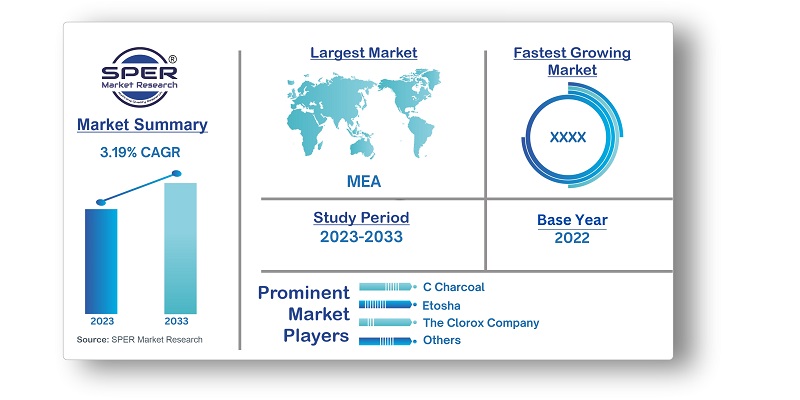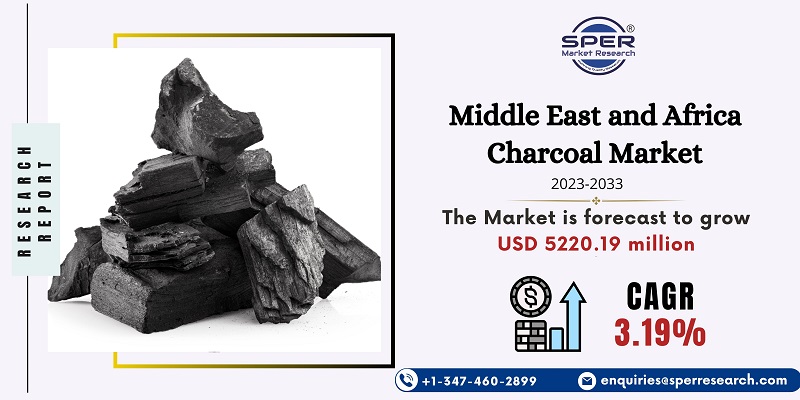
Middle East and Africa Charcoal Market Growth, Size, Trends, Revenue, Demand and Future Outlook
Middle East and Africa Charcoal Market Size- By Product, By Application- Regional Outlook, Competitive Strategies and Segment Forecast to 2033
| Published: Jan-2024 | Report ID: CHEM2410 | Pages: 1 - 159 | Formats*: |
| Category : Chemical & Materials | |||
- The Clorox Company subsidiary Kingsford Products Company introduced a new range of hardwood pellets and signature flavored charcoals in March 2022. This product's primary goal is to enhance grilling by adding different flavors and aromas. This will enhance the company's product line.


| Report Metric | Details |
| Market size available for years | 2019-2033 |
| Base year considered | 2022 |
| Forecast period | 2023-2033 |
| Segments covered | By Product, By Application |
| Regions covered | Saudi Arabia, UAE, South Africa, Egypt, Israel, Rest of Middle East and Africa |
| Companies Covered | C Charcoal, Etosha, Jumbo Charcoal (Pty) Ltd., Mesjaya Sdn Bhd., Namchar, NamCo Charcoal and Timber Products, The Clorox Company. |
- Charcoal Producers and Manufacturers
- Distributors and Suppliers
- Retailers and Wholesalers
- Consumers and End Users
| By Product: |
|
| By Application: |
|
| By Region: |
|
- Middle East and Africa Charcoal Market Size (FY’2023-FY’2033)
- Overview of Middle East and Africa Charcoal Market
- Segmentation of Middle East and Africa Charcoal Market By Product (Lump Charcoal, Charcoal Briquettes, Japanese Charcoal, Sugar Charcoal, Others)
- Segmentation of Middle East and Africa Charcoal Market By Application (Outdoor Activities, Restaurant Business, Metallurgical Fuel, Industrial Fuel, Filtration, Others)
- Expansion Analysis of Middle East and Africa Charcoal Market
- Problems and Obstacles in Middle East and Africa Charcoal Market
- Competitive Landscape in the Middle East and Africa Charcoal Market
- Impact of COVID-19 and Demonetization on Middle East and Africa Charcoal Market
- Details on Current Investment in Middle East and Africa Charcoal Market
- Competitive Analysis of Middle East and Africa Charcoal Market
- Prominent Players in the Middle East and Africa Charcoal Market
- SWOT Analysis of Middle East and Africa Charcoal Market
- Middle East and Africa Charcoal Market Future Outlook and Projections (FY’2023-FY’2033)
- Recommendations from Analyst
1.1. Scope of the report1.2. Market segment analysis
2.1. Research data source2.1.1. Secondary Data2.1.2. Primary Data2.1.3. SPER’s internal database2.1.4. Premium insight from KOL’s2.2. Market size estimation2.2.1. Top-down and Bottom-up approach2.3. Data triangulation
4.1. Driver, Restraint, Opportunity and Challenges analysis4.1.1. Drivers4.1.2. Restraints4.1.3. Opportunities4.1.4. Challenges4.2. COVID-19 Impacts of the Middle East and Africa Charcoal Market
5.1. SWOT Analysis5.1.1. Strengths5.1.2. Weaknesses5.1.3. Opportunities5.1.4. Threats5.2. PESTEL Analysis5.2.1. Political Landscape5.2.2. Economic Landscape5.2.3. Social Landscape5.2.4. Technological Landscape5.2.5. Environmental Landscape5.2.6. Legal Landscape5.3. PORTER’s Five Forces5.3.1. Bargaining power of suppliers5.3.2. Bargaining power of buyers5.3.3. Threat of Substitute5.3.4. Threat of new entrant5.3.5. Competitive rivalry5.4. Heat Map Analysis
6.1. Middle East and Africa Charcoal Market Manufacturing Base Distribution, Sales Area, Product Type6.2. Mergers & Acquisitions, Partnerships, Product Launch, and Collaboration in Middle East and Africa Charcoal Market
7.1. Middle East and Africa Charcoal Market Value Share and Forecast, By Product, 2023-20337.2. Lump Charcoal7.3. Charcoal Briquettes7.4. Japanese Charcoal7.5. Sugar Charcoal7.6. Others
8.1. Middle East and Africa Charcoal Market Value Share and Forecast, By Application, 2023-20338.2. Outdoor Activities8.3. Restaurant Business8.4. Metallurgical Fuel8.5. Industrial Fuel8.6. Filtration8.7. Others
9.1. Middle East and Africa Charcoal Market Size and Market Share
10.1. Middle East and Africa Charcoal Market Size and Market Share By Product (2019-2026)10.2. Middle East and Africa Charcoal Market Size and Market Share By Product (2027-2033)
11.1. Middle East and Africa Charcoal Market Size and Market Share By Application (2019-2026)11.2. Middle East and Africa Charcoal Market Size and Market Share By Application (2027-2033)
12.1. Middle East and Africa Charcoal Market Size and Market Share By Region (2019-2026)12.2. Middle East and Africa Charcoal Market Size and Market Share By Region (2027-2033)12.3. Saudi Arabia12.4. UAE12.5. South Africa12.6. Egypt12.7. Israel12.8. Rest of Middle East and Africa
13.1. C Charcoal13.1.1. Company details13.1.2. Financial outlook13.1.3. Product summary13.1.4. Recent developments13.2. Etosha13.2.1. Company details13.2.2. Financial outlook13.2.3. Product summary13.2.4. Recent developments13.3. Jumbo Charcoal (Pty) Ltd.13.3.1. Company details13.3.2. Financial outlook13.3.3. Product summary13.3.4. Recent developments13.4. Mesjaya Sdn Bhd.13.4.1. Company details13.4.2. Financial outlook13.4.3. Product summary13.4.4. Recent developments13.5. Namchar13.5.1. Company details13.5.2. Financial outlook13.5.3. Product summary13.5.4. Recent developments13.6. NamCo Charcoal and Timber Products13.6.1. Company details13.6.2. Financial outlook13.6.3. Product summary13.6.4. Recent developments13.7. The Clorox Company13.7.1. Company details13.7.2. Financial outlook13.7.3. Product summary13.7.4. Recent developments13.8. Others
SPER Market Research’s methodology uses great emphasis on primary research to ensure that the market intelligence insights are up to date, reliable and accurate. Primary interviews are done with players involved in each phase of a supply chain to analyze the market forecasting. The secondary research method is used to help you fully understand how the future markets and the spending patterns look likes.
The report is based on in-depth qualitative and quantitative analysis of the Product Market. The quantitative analysis involves the application of various projection and sampling techniques. The qualitative analysis involves primary interviews, surveys, and vendor briefings. The data gathered as a result of these processes are validated through experts opinion. Our research methodology entails an ideal mixture of primary and secondary initiatives.



Frequently Asked Questions About This Report
PLACE AN ORDER
Year End Discount
Sample Report
Pre-Purchase Inquiry
NEED CUSTOMIZATION?
Request CustomizationCALL OR EMAIL US
100% Secure Payment






Related Reports
Our Global Clients
Our data-driven insights have influenced the strategy of 200+ reputed companies across the globe.




















